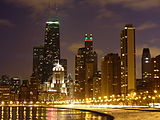Gold Coast Historic District (Chicago)
Gold Coast Historic District | |
 Gold Coast's Oak Street Beach | |
| Location | Roughly bounded by North Ave., Lake Shore Dr., Clark and Oak Sts., Chicago, Illinois |
|---|---|
| Coordinates | 41°54′21″N 87°37′41″W / 41.90583°N 87.62806°W |
| Architect | McKim,Mead & White; multiple |
| Architectural style | Moderne, Italianate, Queen Anne |
| NRHP reference No. | 78001121 |
| Added to NRHP | January 30, 1978[1] |
The Gold Coast Historic District is a historic district in Chicago, Illinois. Part of Chicago's Near North Side community area, it is roughly bounded by North Avenue, Lake Shore Drive, Oak Street, and Clark Street.
The Gold Coast neighborhood grew in the wake of the Great Chicago Fire. In 1882, millionaire Potter Palmer moved to the area from the Prairie Avenue neighborhood on the city's south side. He filled in a swampy area which later became Lake Shore Drive, and built the Palmer Mansion, a forty-two room castle-like structure designed by Henry Ives Cobb and Charles Sumner Frost. Other wealthy Chicagoans followed Potter into the neighborhood, which became one of the richest in Chicago.
In the late 1980s, the Gold Coast and neighboring Streeterville comprised the second most-affluent neighborhood in the United States, behind Manhattan's Upper East Side.[2] Today, the neighborhood is a mixture of mansions, row houses, and high-rise apartments. Highlights include the Astor Street District and the James Charnley House.
The district was added to the National Register of Historic Places in 1978.[1][3]
The nearby East Lake Shore Drive District and parts of northern Streeterville and the Magnificent Mile near the lake also may be considered part of the Gold Coast (such as the area around the famous 860-880 Lake Shore Drive Apartments), even if not technically in the historic designation.[4] The mayor's office map extends the Gold Coast south to the area of Northwestern University's Chicago campus.
The Consulate-General of Poland in Chicago is located at 1530 North Lake Shore Drive,[5] right next to the International Museum of Surgical Science.
As of 2011, Gold Coast ranks as the 7th richest urban neighborhood in America with a median household income of $153,358.[6]

Photos
-
Night on the Gold Coast (including East Lake Shore Drive District)
-
Luxury condominiums on Dearborn Street in the Gold Coast
-
Townhomes on East Division Street in the Gold Coast
-
Cooperative apartments on Lake Shore Drive in the Gold Coast
-
The Gold Coast is a prominent part of the skyline
-
Gold Coast from Streeterville
-
Palmer Mansion (demolished in 1951)
Historical images of Chicago's Gold Coast can be found in Explore Chicago Collections, a digital repository made available by Chicago Collections archives, libraries and other cultural institutions in the city.[7]
Notes
- ^ a b "National Register Information System". National Register of Historic Places. National Park Service. April 15, 2008.
- ^ Don DeBat and Gary S. Meyers. "Manhattan transfer–Streeterville and the Gold Coast : Second plushest neighborhood in U.S. has it all". Chicago Sun-Times. January 13, 1989. 15.
- ^ National Register of Historic Places in Cook County. Retrieved on June 12, 2008.
- ^ "Chicago neighborhoods" (PDF). City of Chicago. Retrieved 2010-04-16.
- ^ "General Info." Consulate-General of Poland in Chicago. Retrieved on January 31, 2009.
- ^ http://www.businessinsider.com/richest-urban-neighborhoods-2011-6?op=1
- ^ Long, Elizabeth. "A Single Portal to Chicago's History". The University of Chicago News. Retrieved 17 September 2016.










